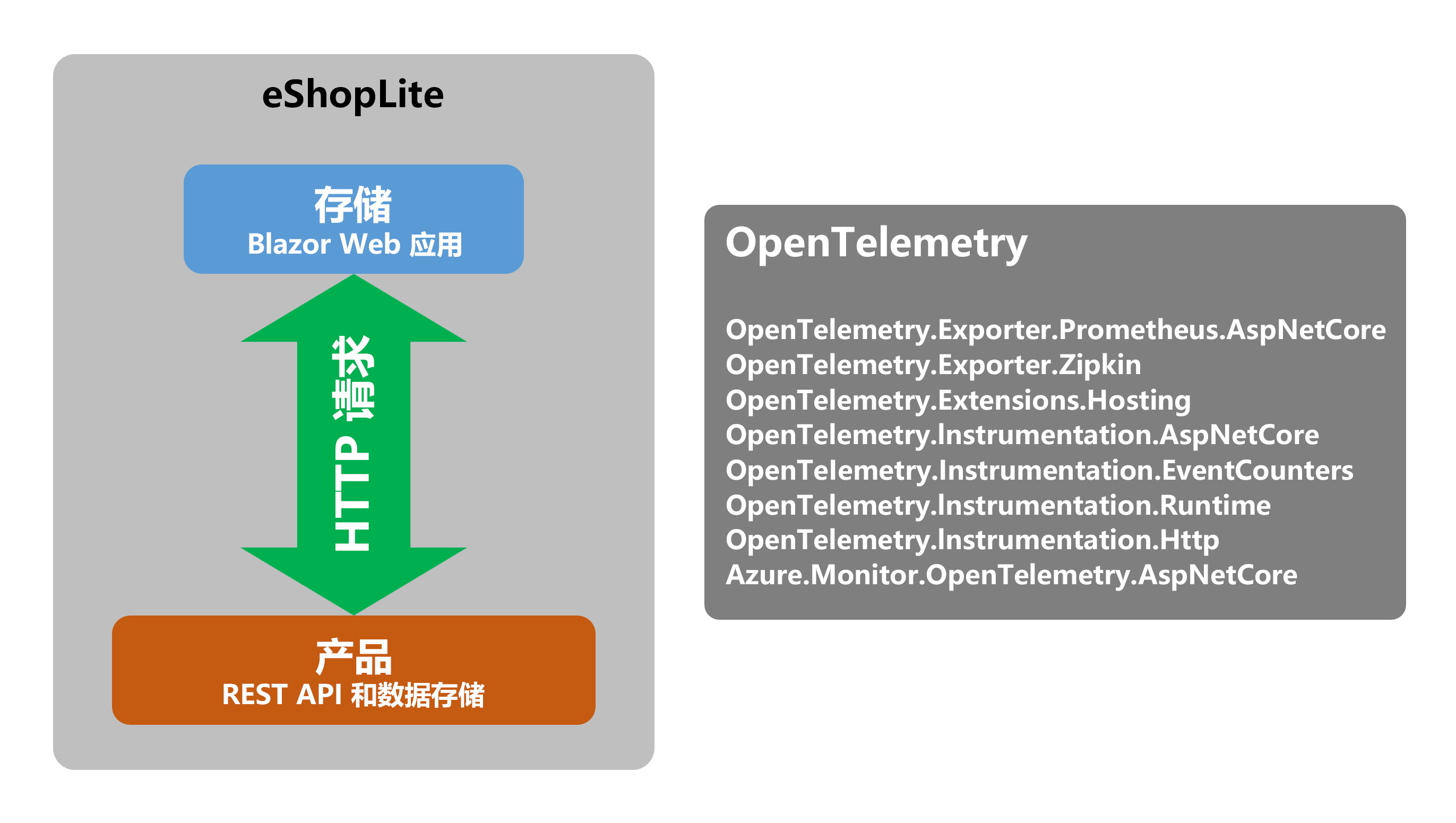向云原生应用程序添加可观测性
现在,你已了解可观测性的重要性,你将了解如何将其包含在云原生应用程序中。 为执行此步骤,请将 OpenTelemetry 添加到应用。
将 OpenTelemetry 添加到应用
.NET 具有丰富的内置可观测性工具生态系统,可生成日志记录、指标和跟踪数据。 可以使用这些工具向云原生应用程序添加可观测性。 这些库包括:
- 日志记录:
Microsoft.Extensions.Logging.ILogger - 指标:
System.Diagnostics.Metrics.Meter - 跟踪:
System.Diagnostics.Activity和System.Diagnostics.ActivitySource
OpenTelemetry 会使用上述所有遥测数据,但云原生应用首先需要通过 NuGet 包添加 OpenTelemetry 支持。 这些包可以分为三个组:
| 类别 | 程序包 | 说明 |
|---|---|---|
| 核心 API | OpenTelemetry | 提供核心 OpenTelemetry 功能的主库。 |
| 核心 API | OpenTelemetry.Extensions.Hosting | 提供用于在 ASP.NET Core 主机中自动启动和停止 OpenTelemetry 跟踪的扩展方法。 |
| 检测 | OpenTelemetry.Instrumentation.AspNetCore | ASP.NET Core 应用程序的检测。 此包会收集有关应用的大量指标,而无需编写任何代码。 |
| 出口商 | OpenTelemetry.Exporter.Console | 通过控制台的导出程序,应用可以将遥测数据写出到控制台。 |
云原生应用中可以包含更多的检测和导出程序包。 有关详细信息,请参阅使用 OpenTelemetry 的 .NET 可观测性。 根据要构建的应用类型,可以添加与你最相关的包。
本模块重点介绍如何将 OpenTelemetry 与 eShopLite 云原生应用配合使用。 由于此应用是使用 .NET Core 和 Blazor WebAssembly 构建的,因此,这意味着所有代码示例都是基于利用依赖项注入的。

可以选择将所有 OpenTelemetry 包同时包含在微服务应用中的“产品”和“Store”服务中。 但在实际应用中,你或拥有更多的服务。 将所有这些包添加到每个服务会涉及不必要的重复。 更好的方法是将新的诊断项目添加到解决方案中,然后任何微服务都可以引用这些项目来观察。
下面是一些用于创建方法 AddObservability 的示例代码,微服务可以调用该方法来使用 OpenTelemetry:
using OpenTelemetry.Metrics;
using OpenTelemetry.Resources;
using OpenTelemetry.Trace;
namespace Microsoft.Extensions.DependencyInjection;
public static class DiagnosticServiceCollectionExtensions
{
public static IServiceCollection AddObservability(this IServiceCollection services,
string serviceName,
IConfiguration configuration)
{
// create the resource that references the service name passed in
var resource = ResourceBuilder.CreateDefault().AddService(serviceName: serviceName, serviceVersion: "1.0");
// add the OpenTelemetry services
var otelBuilder = services.AddOpenTelemetry();
otelBuilder
// add the metrics providers
.WithMetrics(metrics =>
{
metrics
.SetResourceBuilder(resource)
.AddRuntimeInstrumentation()
.AddAspNetCoreInstrumentation()
.AddHttpClientInstrumentation()
.AddEventCountersInstrumentation(c =>
{
c.AddEventSources(
"Microsoft.AspNetCore.Hosting",
"Microsoft-AspNetCore-Server-Kestrel",
"System.Net.Http",
"System.Net.Sockets");
})
.AddMeter("Microsoft.AspNetCore.Hosting", "Microsoft.AspNetCore.Server.Kestrel")
.AddConsoleExporter();
})
// add the tracing providers
.WithTracing(tracing =>
{
tracing.SetResourceBuilder(resource)
.AddAspNetCoreInstrumentation()
.AddHttpClientInstrumentation()
.AddSqlClientInstrumentation();
});
return services;
}
// Add the Prometheus endpoints to your service, this will expose the metrics at http://service/metrics
public static void MapObservability(this IEndpointRouteBuilder routes)
{
routes.MapPrometheusScrapingEndpoint();
}
}
该方法将返回一个 IServiceCollection 类,可将其作为服务添加到 ASP.NET Core WebApplicationBuilder。
然后,此操作会创建一个变量 var otelBuilder = services.AddOpenTelemetry() 来存储 OpenTelemetry 生成器。 然后,代码可以将指标和跟踪添加到 otelBuilder。
例如,此配置添加了以下项的检测:
- ASP.NET Core
- C# 运行时
- HttpCLient
- Kestrel Web 服务器
这些指标显示在控制台中。 .AddConsoleExporter() 方法将导出程序添加到生成器。
它还会将跟踪添加到控制台,用于:
- ASP.NET Core
- HttpClient
- SQL 客户端
最后一行会返回 IServiceCollection 类。
完成诊断项目后,只需向项目添加引用并向服务添加一行代码即可。 例如,要在“产品”服务中包含 OpenTelemetry,请在 Product.csproj 文件中添加项目引用:
<ProjectReference Include="..\Diagnostics\Diagnostics.csproj" />
然后,将以下行添加到 builder 声明下的 Program.cs 文件中:
var builder = WebApplication.CreateBuilder(args);
builder.Services.AddObservability("Products", builder.Configuration);
让我们将此代码添加到 eShopLite 应用中的“产品”服务。